#clean fuels
Photo

The vast majority of the world is unaware of the true cost of clean marine fuels. It's an industry built on a carefully constructed illusion, one that most people never see past. But I know the dirty facts, because I'm the one who's been cleaning up their messes for years. There's a reason the big oil companies are so interested in renewables, and it's not because they care about the environment. It's because they know that the sooner renewables become mainstream, the sooner the dirty truth about clean marine fuels will be exposed. It's a sham, a way to clean up their image and make a quick buck. But I'm not going to let them get away with it. I'm going to blow the whistle on their dirty little secret.
#Engines & Fuel#Ferries#Passenger#ammonia#biodiesel#California Air Resources Board#Casco Bay Lines#clean fuels#e-methanol#Elliott Bay Design Group#emissions#hydrogen#Hydrogen One#LNG#marine emissions#marine fuel#Michael Complita#Trust for Governors Island#fault#Clean marine fuels#illusion#dirty facts#renewables#sham
0 notes
Text
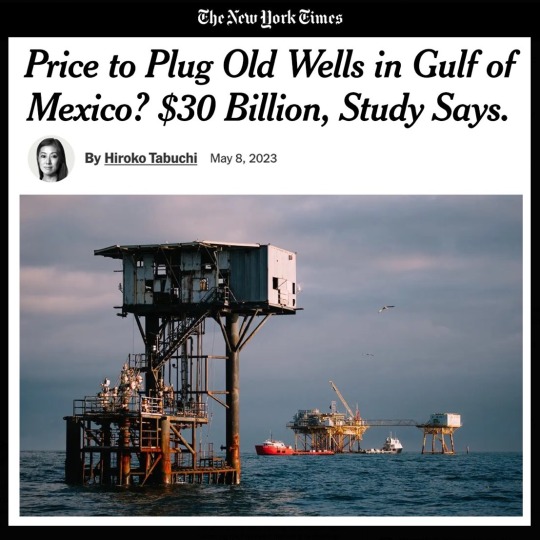
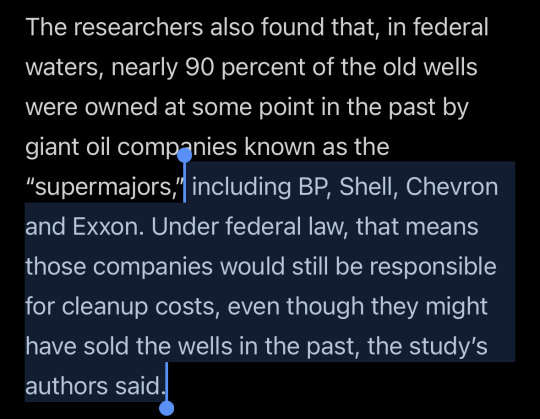
Source
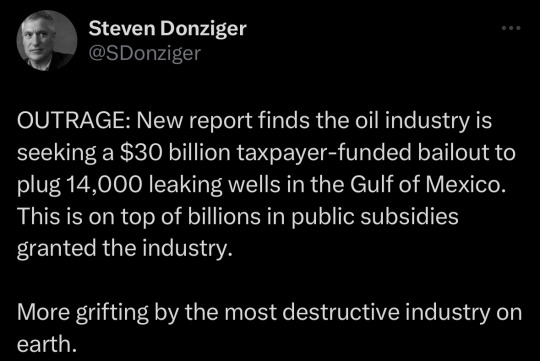
#climate change#fossil fuels#politics#us politics#government#the left#environment#water#clean water#energy#twitter post#progressive#green new deal#ban fossil fuels#environmentalism#environmental justice
12K notes
·
View notes
Text
Scientists have developed a new solar-powered system to convert saltwater into fresh drinking water which they say could help reduce dangerous the risk of waterborne diseases like cholera.
Via tests in rural communities, they showed that the process is more than 20% cheaper than traditional methods and can be deployed in rural locations around the globe.
Building on existing processes that convert saline groundwater to freshwater, the researchers from King’s College London, in collaboration with MIT and the Helmholtz Institute for Renewable Energy Systems, created a new system that produced consistent levels of water using solar power, and reported it in a paper published recently in Nature Water.
It works through a process called electrodialysis which separates the salt using a set of specialized membranes that channel salt ions into a stream of brine, leaving the water fresh and drinkable. By flexibly adjusting the voltage and the rate at which salt water flowed through the system, the researchers developed a system that adjusts to variable sunshine while not compromising on the amount of fresh drinking water produced.
Using data first gathered in the village of Chelleru near Hyderabad in India, and then recreating these conditions of the village in New Mexico, the team successfully converted up to 10 cubic meters, or several bathtubs worth of fresh drinking water. This was enough for 3,000 people a day with the process continuing to run regardless of variable solar power caused by cloud coverage and rain.
[Note: Not sure what metric they're using to calculate daily water needs here. Presumably this is drinking water only.]
Dr. Wei He from the Department of Engineering at King’s College London believes the new technology could bring massive benefits to rural communities, not only increasing the supply of drinking water but also bringing health benefits.
“By offering a cheap, eco-friendly alternative that can be operated off the grid, our technology enables communities to tap into alternative water sources (such as deep aquifers or saline water) to address water scarcity and contamination in traditional water supplies,” said He.
“This technology can expand water sources available to communities beyond traditional ones and by providing water from uncontaminated saline sources, may help combat water scarcity or unexpected emergencies when conventional water supplies are disrupted, for example like the recent cholera outbreaks in Zambia.”
In the global rural population, 1.6 billion people face water scarcity, many of whom are reliant on stressed reserves of groundwater lying beneath the Earth’s surface.
However, worldwide 56% of groundwater is saline and unsuitable for consumption. This issue is particularly prevalent in India, where 60% of the land harbors undrinkable saline water. Consequently, there is a pressing need for efficient desalination methods to create fresh drinking water cheaply, and at scale.
Traditional desalination technology has relied either on costly batteries in off-grid systems or a grid system to supply the energy necessary to remove salt from the water. In developing countries’ rural areas, however, grid infrastructure can be unreliable and is largely reliant on fossil fuels...
“By removing the need for a grid system entirely and cutting reliance on battery tech by 92%, our system can provide reliable access to safe drinking water, entirely emission-free, onsite, and at a discount of roughly 22% to the people who need it compared to traditional methods,” He said.
The system also has the potential to be used outside of developing areas, particularly in agriculture where climate change is leading to unstable reserves of fresh water for irrigation.
The team plans to scale up the availability of the technology across India through collaboration with local partners. Beyond this, a team from MIT also plans to create a start-up to commercialize and fund the technology.
“While the US and UK have more stable, diversified grids than most countries, they still rely on fossil fuels. By removing fossil fuels from the equation for energy-hungry sectors like agriculture, we can help accelerate the transition to Net Zero,” He said.
-via Good News Network, April 2, 2024
#water#water scarcity#clean water#saline#desalination#off grid#battery technology#solar power#solar energy#fossil fuels#water shortage#india#hyderabad#new mexico#united states#uk#united kingdom#good news#hope#aquifers
857 notes
·
View notes
Text
#clean energy#green energy#sustainability#climate change#environment#good news#hope#climate anxiety#fossil fuels
749 notes
·
View notes
Text


Front and back ✨
Treat me ~ Tip Me ~ More of me
#Putting more green in my hair and avoiding cleaning the inside of the oven today. Amongst a stupid number of tasks I put off yesterday#I always say Well That Is Tomorrow Me's Problem. well guess what! It's tomorrow now me#From last night#I still cant move my head properly but I cannot leave so many tasks undone#This is gonna be a heavily painkiller fueled day. Wish me luck.#satans knitwear#pretty lingerie#alt pinup#pinup girl#girls with piercings#cheeky#bi girl#wlw#uk girl#My gif to you
380 notes
·
View notes
Text

Forehead Kiss
#myart#windydrawallday fanart#ifellinrobothellagain#lockprowl#prowldown#shipping to the moon and back#i keep getting annoying anon asks sooo#i will fuel my creative energy with SPITE#then ill open the file with my bazillion sketches of these two#and ill chose one to detail a bit and share#i usually prefer to have time to do my full rendering but this is a good excuse to clean up some of them haha#EDIT 11-12#prowllock
170 notes
·
View notes
Text








bunch of screenshots from the off book livestream, shoutout shoutout to everyone who was in the chat 🌋🪽🌴
#off book#off book podcast#super fun show#also adding fuel to my belief that zach and jess would be great if they ever did a bloodkeep sequel#let them be funny little tolkien villains they’re ready for it#also I drew Jacques + felipe and the palm tree ents which i may clean up and post or like put in the discord or something
51 notes
·
View notes
Text
#european union#good news#fossil fuels#clean energy#green energy#environmentalism#science#environment#climate change#climate crisis#europe
21 notes
·
View notes
Note
I wanna add that sun isn't what Wukong's surname means so he has a moment of "... that's not what my name means." while Macaque is internally strangling younger him for taking the opportunity for a freaking pun.
YOU ARE SO RIGHT ANON 😂😂😂😂
Wukong, very confused still and probably a little concerned: Mac….you do know my surname doesn’t actually mean the sun….right?
Macaque, doing everything in his power not to run away from this conversation: obviously :)
#meanwhile MK is trying to piece together why Mackerel is getting flustered and Mei & Tang just sit back w/ popcorn enraptured#thank you for fueling this even more anon i love you 💕#lmk#lego monkie kid#lmk sun wukong#lmk macaque#lmk six eared macaque#shadowpeach#mac ‘n cheese sure is wishing he could go back in time and stop his past decision fun pun be damned#swk is now left considering if macaroni thought his surname was always literal like his own (six ears) this is so funny to me help#macaque who’s definitely read the entirety of JTTW can’t even come clean bc he never thought this would reach swk 😂#this is canon to me now#asks#anonymous#anons my beloved 😘
119 notes
·
View notes
Text
mac & dennis: two sides of the same abandonment issues coin.
dennis pushing people away and leaving them so nobody can get the chance to leave him first vs mac needing constant contact and trying to be the "protector" so people feel safe enough to stay with him. their relationship being built on abandonment issues and a revolving door of "please dont leave me" with dennis' "i need to be the one who leaves" vs mac's "i need to make you stay" complexes, which is why their relationship works so well. theyve perfected this method of tug of war, where dennis will pull away and mac will pull him back, or mac will pull away and dennis will pull him back -- nobody else can perfect this method better than themselves; theyve been doing this for 20+yrs after all
#sorry but. i was cleaning & then i started thinking. i am mentally ill#& also. their abandonment issues fuel their codependency. they dont want the other person to leave them#so they make sure the other person has a reason to stay w/ them. mac is the protector ('and thts y ur all safe as long as im around')#& dennis is the provider ('u dont actually own anything in this apartment')#sorry. im just really ill abt them <3#iasip#macdennis#mac mcdonald#dennis reynolds#gt.txt
193 notes
·
View notes
Text
sorry but as someone who *had to* live in a van I will never understand all these trust fund kids who *choose to* live in a van
#it sucks. especially if you live in a van WITH someone. they will get on your every last nerve because youre sharing such a small space#shit will go missing that you need#it will never be as clean or organized as it was when you took those aesthetic pictures#and the amount of $ youll spend on gas for your not-at-all-fuel-efficient conversion van is astronomical#nasty people who hate the homeless bc theyre edgelords or far right will slash your tires and smash your windows#actually probably not if your van home is ☆aesthetic☆ vs literally homeless tbh#sorry i just fucking hate how homelessness is getting gentrified and trendy when actual homeless people are suffering
135 notes
·
View notes
Text



My airplane dragon friends! They are part of a civilization of dragons living in the eye of a never-ending storm. Over the course of thousands of years and many generations, these dragons evolved to become bio-mechanical in appearance, usually resembling aircraft of some sort. The animals here, too, are powered internally by gears and hydraulics.
Xevon (he/it/xe) is an outcast who is deeply bored of routine and wants to venture outside the eye of the storm.
Cirrus (he/they) is Xevon's boyfriend, and prefers a quiet life of reading and writing. But where Xevon goes, Cirrus follows.
Zoleil (she/they/it) is the fastest racer in the world, and a butch lesbian icon with dozens of women lining up for an autograph. She has been ordered to find Xevon and Cirrus and return them to safety.
#furry#weirdfur#airplane dragon#aeromorph#clean furry#reference sheet#i know nothing about planes so i just picked ones i think looked cool to base these designs on!#they are mostly biological. but with some mechanical aspects to their wings and tails that allow them to fly!#they drink all different kinds of fuel which are mined and gathered and farmed basically!#there are fossil fuels and clean fuels. clean fuels taste better and some more progressive plane dragons have a diet of strictly clean fuel#the airplane dragon species was created by scpkid!#zoleil#cirrus#xevon
265 notes
·
View notes
Text
Countries That Generate 100% Renewable Energy Electricity
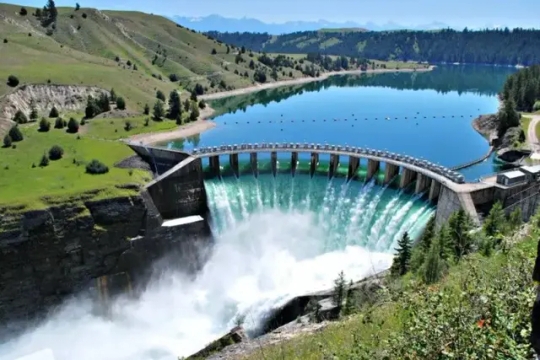
Pictured: Hydropower is the most widely used source of renewable energy-generated electricity. This dam is located near Polson, Montana.
Is 100% Renewable Resource-Generated Electricity Possible?
"With concerns growing regarding burning fossil fuels and their connection to global warming, a great debate is occurring regarding the feasibility of producing electricity entirely from non-carbon emitting green renewable energy sources such as geothermal, hydroelectric, wind, and solar. Skeptics and naysayers claim that achieving such a goal is impractical, would destroy the economy, and is in the realm of pie-in-the-sky thinking.
But is it actually impractical and unattainable? The answer is clearly "no" since there are already several countries that generate 100% of the electricity they use from renewable sources of energy. There are also many other countries that obtain over 90% of the electricity they use from renewable energy sources. Despite the negative rhetoric by some, there’s nothing impractical about using renewable energy to generate electricity on a grand scale.
The Countries Leading the Way to a 100% Renewable Energy Electricity Future
The following is a list of countries that are leading the world into the new frontier of economies that run their electrical grids either entirely or nearly entirely on renewable energy per a 2018 report by the International Renewable Energy Association (IREA) and the U.S. Energy Information Administration (EIA) statistics. This list and the percentages are subject to change over time, but it provides a good snapshot of just how practical renewable energy currently is for electricity generation.
Iceland obtains 100% of the electricity it needs from renewable energy sources. Iceland is somewhat unique since volcanic activity on the island provides a significant geothermal energy source that is utilized to provide approximately one-quarter of the country’s electricity. The remaining three quarters are provided by hydro-power.
Paraguay obtains 100% of the electricity it uses from renewable sources. Huge hydropower dams provide all of Paraguay's electricity needs, as well as supply neighboring Argentina and Brazil with electricity.
Costa Rica is another country leading the way towards 100% renewable-produced electricity. During 2018, Costa Rica met all of its electricity needs using renewable energy sources such as hydro-power, geothermal, biomass, wind, and solar for 300 days in a row.
Ethiopia, Kenya, Namibia, Norway, Tajikistan, and Uruguay are countries currently generating greater than 90% of the electricity they use from renewable energy sources. Some of these countries are working towards running their electric networks entirely from renewable energy.
Some things stand out from the list of countries leading the way in electricity generated from renewable energy.
They are relatively small countries.
They have abundant renewable natural resources, particularly abundant water resources available to generate hydro-power.
The list includes both wealthy developed and poor developing countries.
The fact that both developed wealthy countries and poor developing countries are leaders in renewable energy-produced electricity indicates that the cost of constructing renewable energy resources is not a limiting factor. In fact, developing countries can justify the capital cost of building renewable energy sources of electricity due to the fact that the operating costs are relatively low and predictable (not subject to commodity price swings), and renewable energy allows a country to be self-sufficient in meeting its electricity needs.
Large Developed Countries Can Also Produce 100% Of Their Electricity From Renewable Energy
Critics and naysayers might say that while these achievements by small countries are impressive, implementing renewable energy on a large scale is impractical for larger developed countries. But is it really impractical?
Cost and technological barriers are not what they once were for renewable energy. In fact, costs for renewable energy continue to decline year after year, and renewable energy technologies continue to develop and become more efficient. Many countries have not even come close to tapping their renewable energy potential or even tried some of the technologies available, such as electricity generated by wave or tidal power. Additionally, the argument that renewable energy is only useful when it is being generated is becoming irrelevant since large utility-scale batteries are now available that have the capability to store electricity generated by renewable energy and allow it to be used when needed.
Clearly, the answer is yes. Large developed countries can produce 100% of the electricity they need from renewable sources. It is only a matter of the will and investment at this point to make the changeover from fossil fuel-generated electricity to renewable energy electricity generation. The technical barriers are not as great as naysayers claim, as proven by smaller countries that have already reached the 100% threshold. Moving towards 100% renewable energy sources of electricity will become easier over time as wind, solar, and other renewables become more efficient and large utility-scale battery storage technologies become capable of storing larger quantities of energy for use when needed.
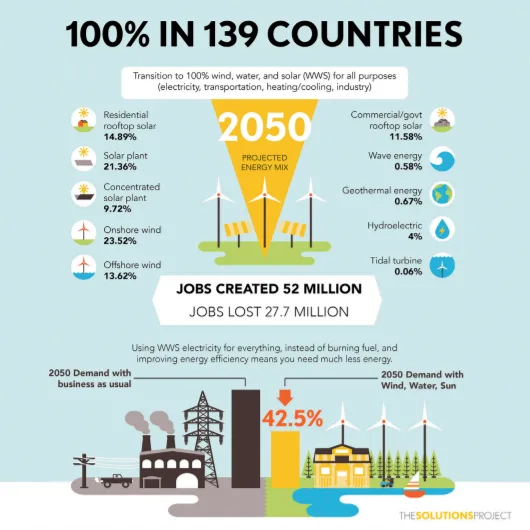
Pictured: Researchers lay out a plan for nearly 140 countries that could be powered 100 percent by renewable energy by 2050. spectrum.ieee.org
The City of Los Angeles Leads the Way in the U.S. With Inexpensive Solar
Various forms of renewable energy have experienced significant cost reductions to a point at which they are competitive and, in some cases, cheaper than traditional electrical energy sources such as coal, oil, and natural gas. This cost reduction trend will accelerate the change over to renewable sources of electricity. For example, the City of Los Angeles signed a deal in July 2019 for a large solar electricity array that will provide 7% of the city's electricity by 2025 at only two cents per kilowatt-hour (kWh). This is far cheaper than fossil fuel-derived electricity.
In addition to being cost-competitive, the practicality and reliability of renewable energy are poised to make major advances as large utility-scale battery technologies are rolled out that can be used to capture renewable energy when it is created, so the electricity can be used at a later time when needed. The Los Angeles solar array project includes utility-scale battery backup at a cost of 1.3 cents per kWh, so the electricity generated by the sun will be available even when the sun is not shining.
Los Angeles has a goal of achieving 100% renewable electricity generation by 2050. This solar contract is a big step toward achieving their goal."
-via TurboFuture, February 21, 2023
#renewables#renewablefuture#renewable energy#clean energy#green energy#solar power#solar panels#fossil fuels#climate crisis#climate change#global warming#hydropower#geothermal#wind power#wind turbines#iceland#paraguay#costa rica#ethiopia#kenya#namibia#norway#tajikistan#uruguay#united states#los angeles#battery#hope posting#hopepunk#sustainability
316 notes
·
View notes
Text
okay okay listen what if the reason that utahime doesn’t like gojo isn’t just because he’s annoying and unserious,
but also because she’s mad at him for basically forgetting about shoko after geto left
#i think it explains her animosity toward him well#and also fuel for shokohime which listen#after that one side moment w the second years cleaning#and utahime happily calling shoko#yeah they’re canon#jjk#jujutsu kaisen#jjk manga#shokohime#gojo#satoru gojo#utahime#shoko#but we’re shown multiple times that shoko and utahime seem close so
61 notes
·
View notes
Text
"There is a small panel of regulators in every state that holds a similar power over electricity generation and, by extension, an enormous segment of the United States’ greenhouse gas emissions that are warming the planet. By setting electricity prices, they also have a substantial impact on most people’s lives and pocketbooks. Yet, in Georgia and elsewhere, these groups — known as public service or public utility commissions — get little attention or scrutiny outside of energy wonk circles. Their hearings and documents tend to be long and jargon-heavy, covered in the media by a small group of specialized reporters, making it hard to engage with the process.
This year, Grist and WABE will try to demystify energy regulation in Georgia and beyond. We’ll bring you stories on not only how your power gets made, but how those decisions happen — and how residents who vote and pay electricity bills can get involved."
-via Grist, March 5, 2024. See link for more details (especially in Georgia) and more ways to get involved.
#clean energy#green energy#renewable energy#climate crisis#fossil fuels#elected officials#2024 elections#us election#united states#us politics#state politics#georgia#solar power#wind power#utilities#activism#climate activism#organizing#action post#hope
18 notes
·
View notes
Text



here's how harpy!hunter can still win
#whatever. sometimes u gotta draw some self indulgent shit u know ?#the owl house#hunter toh#what if...... h e was bird ? much to think about .#toh#myart#EDIT: tweaked the lineless colors + cleaned up the og drawing a little :]#spoilers in the next tag dont read unless uve seen the ep >>>>#as devastated as i am by flapjacks death#it DID give so much fuel to this au/headcanon#harpy!hunter enjoyers stay winning !!! (starts sobbing)#toh spoilers#in the tags. only very vaguely in the art lol
238 notes
·
View notes